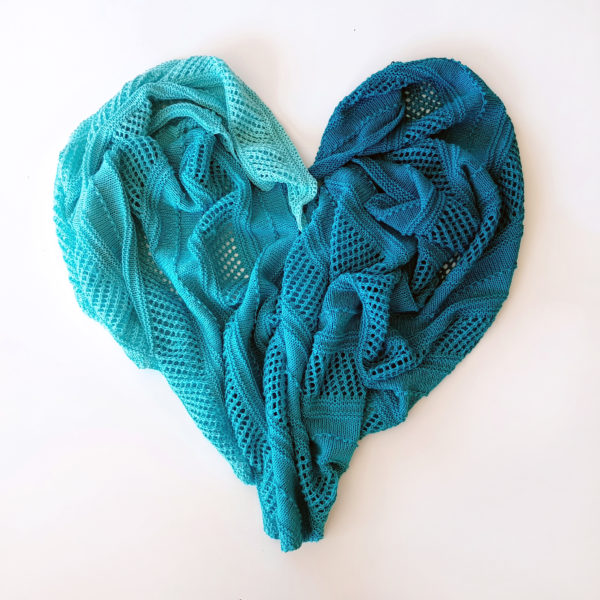 Scheepjes Whirl Ombré in Turquoise Turntable
Scheepjes Whirl Ombré in Turquoise Turntable
Hello everyone! I’m so excited to share my finished Glacia shawl with you! All that’s left now is for me to put the final polish on the pattern, make the PDF’s and do all of the other fun pattern release stuff there is to do, but I thought you’d like to get a good look at it in the meantime.
Spring has sprung here in France and the fields here are a sea of dandelions at the moment, which is wonderful for all the bees and other tiny beasties. We had beautifully sunny weather, then a rainy stretch which left me waiting for the right day to get out and take some photos. I didn’t really want indoor photos of this one for some reason. Anyway, I was finally able to get out there yesterday and get some visuals for you!
The Glacia shawl is the Water elemental instalment of the series, focusing on how increases and decreases create shape and texture in your work. You see this in many different aspects of the shawl… let’s have a closer look!
SHAPE
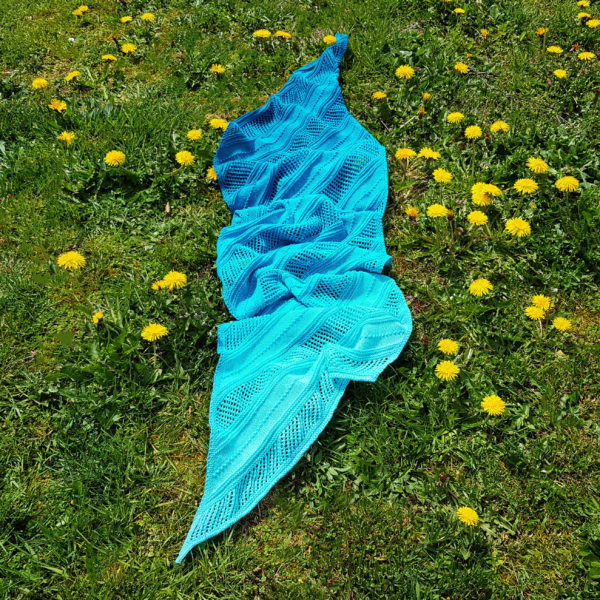
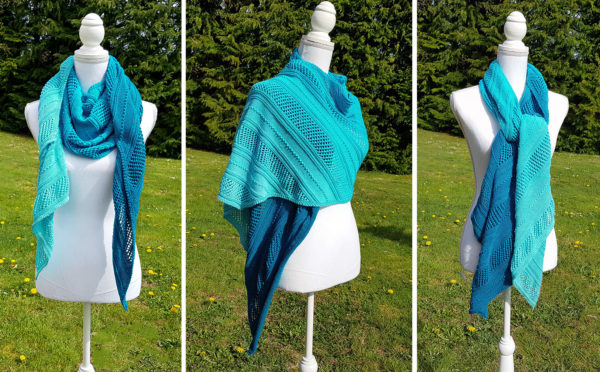
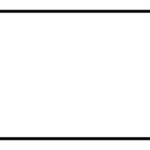 You will see how the simple combination of an increase and a decrease can change a plain rectangle into an interesting parallelogram shape. What I like about this shape is how it changes the look of how the shawl hangs. It has a long point on each end which whirls and twirls as you wear it, giving your shawl a different drape and appearance than a squared off edge.
You will see how the simple combination of an increase and a decrease can change a plain rectangle into an interesting parallelogram shape. What I like about this shape is how it changes the look of how the shawl hangs. It has a long point on each end which whirls and twirls as you wear it, giving your shawl a different drape and appearance than a squared off edge.
TEXTURE
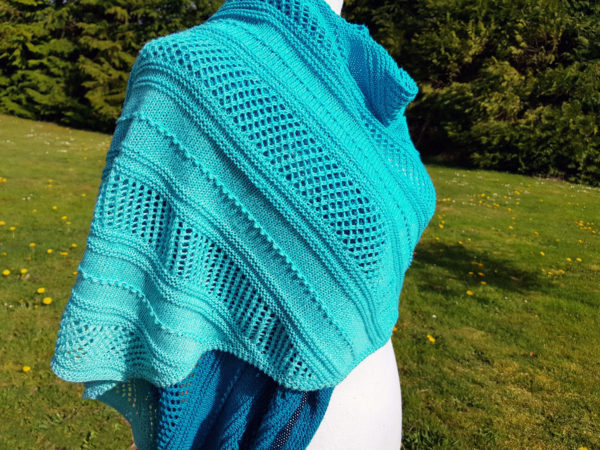
All of the texture in this shawl is created using increase and decrease stitches in different ways, together with a bit of regular knit and purl. In the pattern repeats you have three different texture elements which are created using three different methods. The first texture in the shawl is the row of knotted stitches. This is a lovely touch that is made with a combination of both increases and decreases within a single stitch. You also have two eyelet sections using two different decreases, showing you how the simple change between one decrease stitch to another can change the a minor detail. From a distance they look the same but when you look closely you will see that the raised stitches of the two sections lean in opposite directions.
DETAIL
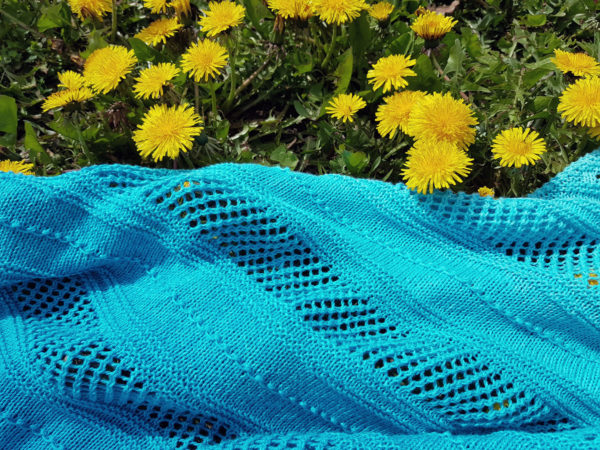
The thing about knitting is that it can be quite delicate work and everything lies in the fine details. That’s what I love about this craft, that changing a single stitch can make a major difference, or change a minor detail that affects the overall project in a larger way. For example, using one decrease stitch over another, like in the eyelet sections of this shawl, doesn’t make a major impact, but does create a noticeable difference when you look closely. The change in decrease stitch causes the raised stitches, or ‘bars’ of the eyelet sections to lean in opposite directions. Not something you notice right away, but only on closer inspection.
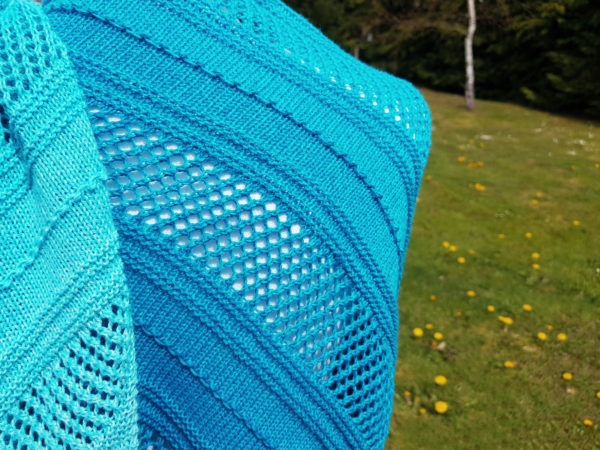
The knotted stitch is a simplistic but beautiful example of a textured detail created by using a combination of increases and decreases in a single stitch. It’s a lovely detail which I think stands out beautifully against the stockinette stitch. It’s not something I’d want to do an entire shawl with, as it can be a little fiddly until you get used to it (but don’t worry, you will get used to it), but for an accent row, it’s perfection.
Watching these stitches being used in different ways will help you recognise what these increase and decrease stitches actually do in your patterns. It’s not always about just taking away a stitch or adding one, but about how you use them and where. My hopes is that by making this shawl, you will achieve a greater understanding of the stitches you are using and the work you are creating and enjoy knitting all the more for it.
I’ll be back soon with the pattern!
Knit
Purl
K2tog (knit two together)
K3tog (knit three together)
Kfb (knit front back)
Sl wyib (slip stitch with yarn in back)
Ssk (slip, slip, knit)
Tbl (through back loop)
Yo (yarn over)
WHERE TO BUY
If you would like to prepare ahead, this project can be made with any Scheepjes Whirl, Woolly Whirl, Frosted Whirl or Whirlette!
UK and International buyers can find Whirl at Woolwarehouse, Black Sheep Wools and Deramores.
Canadian and International buyers have a great option with Knotty House.
Those of you in the Netherlands can find all you need at Caro’s Atelier.
You can also ask your preferred Scheepjes retailer or find a shop near you!
This post contains affiliate links. This is a way for you to support Canadutch and me as a designer. It is no extra cost to you, but if you shop via one of these links, I get a small percentage of the sale!

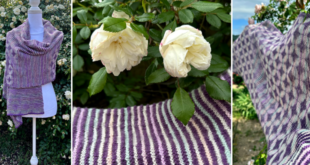
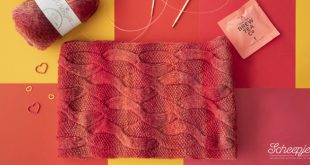
I love the pattern for Glacia Shawl!! Just a quick question does the increase in Row19 and the decrease in Row20 end-up with 135 stitches again? I am not sure if my technique is correct.
Hi Charlene, so glad you are enjoying the pattern! Yes, the stitch count for the shawl never changes, except temporarily in row 19. Here is how it works between these rows.
You start with 135 sts.
Row 19 Kfb, k4, *(k1, yo, k1) into the next st, sl1 wyib; rep from * to 6 sts left, k3, k2tog, k1.
Row 20 K5, (sl1 wyib, k3tog tbl) to 6 sts left, sl1 wyib, k5.
In row 19 Your kfb increase is +1 stitch, which is canceled out at the end by your k2tog decrease which is -1 again.
When you make your (k1, yo, k1) into the stitches in row 19, that is a temporary increase in your stitch count when you go from one stitch to 3 stitches in those spaces. This is then canceled again in row 20 when you do your k3tog tbl, which brings them back to a single stitch again.
If you are still having trouble, let me know and I’ll see if we can figure out where the problem is. :)
Is the pattern translatet to Danish
Hi Dorthe, at this moment the pattern is available in English only.
Thank you
What size needle do you recommend and if I use circular what size cable? TIA
I knitted with a 3mm and 40cm cable, but you will use whatever needle you need to match the gauge given in the pattern (which will be out in the next few days :) )
Hmmmm… I wonder how easy it would be to transfer to a loom pattern. Do you have any overly funky stitches? Or are they pretty basic?
I really have no idea. I’m not familiar with loom knitting at all. There are multiple stitches within a single stitch, so I’m not sure how that works on a loom?
So pretty! How soon is your ‘soon’ for the pattern release? My turquoise turntable whirl is arriving tomorrow, I’m ready ;)
Pretty soon, within the next couple of days, I think. :) Definitely before the middle of next week!